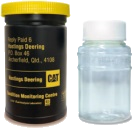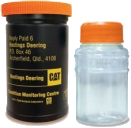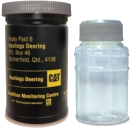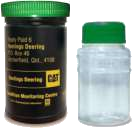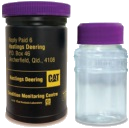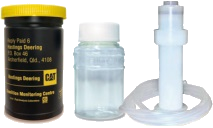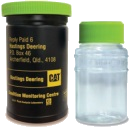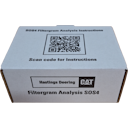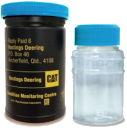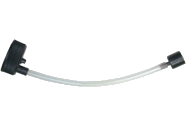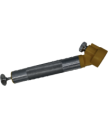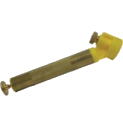Oil Analysis
Heavy mobile equipment and plant is frequently exposed to severe environmental and working conditions, so regular maintenance is necessary. Taking a preventative approach to maintenance with an effective fluid and condition monitoring program will help to maximise the investment in your equipment, by reducing unexpected failures and costly unscheduled downtime.
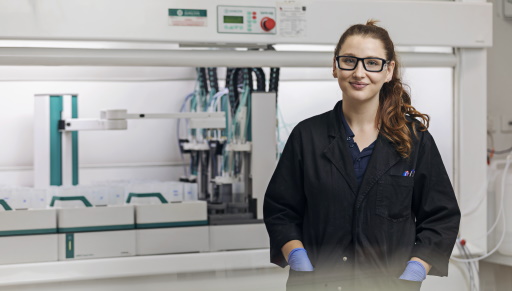
Elemental Analysis
Elemental analysis is an integral part of our Fluid Analysis program that helps you maintain equipment performance and maximize availability. Through regularly scheduled testing of oil samples from your engine, hydraulics, powertrain and other lubricated compartments, elemental analysis detects tiny metal particles caused by component wear.
Every oil-washed system produces wear metals in everyday operation. If wear accelerates, the concentration of wear metal particles increases, signalling a problem. Elemental analysis allows you to find problems before they result in major repairs or machine failure.
Elements typically identified through elemental analysis are aluminium, antimony, barium, boron, cadmium, calcium, chromium, cobalt, copper, iron, lead, magnesium, manganese, molybdenum, nickel, phosphorus, potassium, silicon, silver, sodium, sulfur, tin, titanium, vanadium and zinc.
Viscosity
The viscosity of a liquid is a measure of its internal friction or its readiness to flow. Various factors contribute to a fluid's viscosity and one of the main things that changes a fluid's viscosity is temperature.
Our laboratory routinely analyses the viscosity of oil samples using an instrument that measures "Kinematic Viscosity". For most samples this involves reading the viscosity of the sample at a fixed temperature of 40 degrees Celcius. For engine samples, an additional reading is taken at 100 degrees to check the oil's viscosity closer to the engine's running temperature.
One of the major causes of viscosity problems in engines is fuel dilution. As fuel mixes with the oil, it reduces the overall kinematic viscosity of the oil, thereby compromising the oil's ability to maintain adequate film thickness.

Infrared Analysis
Oxygen exposure, heat and contaminants cause all oils to degrade. Engine oil is particularly susceptible to degradation by sulfur, nitration, by-products of combustion, high temperatures, and water from the combustion process or condensation.
Infrared analysis (also known as oil condition analysis), is part of the comprehensive oil analysis program undertaken at Hastings Deering. It helps prevent component damage by monitoring your oil and keeping track of its degradation and combustion efficiency. This analysis also allows you to correct problems that affect oil performance. The bottom-line benefit: maximum oil performance, optimum oil change intervals and reduced repair costs.
This testing process will provide information about the oil's soot content, oxidation, nitration and sulfation.
Particle Count
Counting the tiny particles in an oil sample identifies harmful contaminants that shorten component life. It can also pinpoint larger particles that signal imminent equipment failure.
This analysis will identify particles as small as 4 microns in size and will also identify particles greater than 50 microns, something that elemental analysis will not detect. The automatic particle counters used at our laboratory analyse each sample using size channels that range from 4 to 50 microns and will also report the ISO cleanliness code, which makes identifying clean and dirty oils much easier than looking at the raw particle counts.
Elemental analysis allows you to find problems before they result in major repairs or machine failure.
PQ Index
PQ Index measures the overall ferrous content present within an oil sample. This content could be comprised of large pieces of metal or tiny particles suspended in the oil. The higher the PQ value, the more contaminated the sample is with ferrous metal. PQ Index is a dimensionless value, so the value is not reported using any units.
PQ Index can detect imminent failures in equipment in some cases where elemental analysis will not. If gears are chipping in a component, large pieces of ferrous metal may be present in the samples. These larger pieces of metal will be detected by the PQ instrument (if they are ferrous), but not necessarily detected during either elemental or particle count analysis, since these instruments are designed to detect microscopic amounts of metal.
Note: PQ index will not detect contamination from non-ferrous sources. eg. Components constructed from aluminium and brass will not be detected by PQ index.
Water
Oil samples can become contaminated with water in several ways. By-products from combustion, condensation and external ingress are the main mechanisms by which water can enter a compartment. Water contamination reduces an oil's effectiveness to lubricate and can rapidly cause damage to components.
Water testing performed at our laboratory can be carried out in one of three ways. The first test involves dropping some sample onto a hotplate with a fixed temperature. This is a rough test but can quickly identify samples containing large amounts of water. The second type of testing is Infrared analysis, where water is detected by changes occuring in the oil.
The third type of water testing offered by our laboratory is Karl Fischer testing. This test uses a titration method and can quantify water very accurately. This test is not included in our basic oil analysis kit and must be purchased as an additional test.
Acid/Base Number
Total Acid Number (TAN) refers to the amount of acidic compounds present in the oil. These compounds increase the probability of corrosion occuring within a compartment.
Total Base Number (TBN) measures the alkaline reserve left in the oil. These additives exist to combat the acidic compounds that can form in the oil through processes such as combustion.
TAN and TBN analysis results are typically used to try and optimise oil change intervals, instead of changing the oil at fixed periods.
Visual Inspection
Samples are routinely inspected by an operator, looking for any abnormal contaminants. Large pieces of metal, free water, and any other foreign substances can be detected using this technique.
Additional Testing
Additional testing is available on oil samples and is included with some of the specialized kits provided by the fluid testing laboratory. These tests include Rapid Filtergrams, RPVOT, MPC, Glycol in Oil, RULER, Sugar Contamination and ASTM Colour.
Rapid Filtergrams are included in the premium oil sample test kits and involves analysis of the sample under a Microscope which also includes a quantification of the material, wear mechanism and size. This test will also include a representative image of the sample, as taken under the microscope, typically at 500x magnification. A graph also accompanies the image, plotting the wear mechanism against the size, showing the overall severity of the contamination.
RPVOT (Rotary Pressure Vessel Oxidation Test). This is an accelerated oil aging test to measure the long term performance of the oil. The result, reported in minutes, indicates the remaining oxidative test life of in-service oil. It is traditionally used for testing large volumes of oil that are expected to last for long periods. Typical applications are Turbine, Hydraulic, Compressor and other large volume systems. (HD Kit Part Number SOS20_700).
MPC (Membrane Patch Colorimetry, also known as the Varnish Potential test). This method measures the colour change on a filter patch of an in-service oil as an indicator of varnish. It is used in conjunction with Particle Counting to monitor when the lubricant produces harmful sludge and varnish. Varnish and insoluble material can affect valve operation in hydraulic systems along with influencing the load carrying ability of the oil. (HD Kit Part Number SOS13_700)
Glycol in Oil testing is used to detect coolant entry in some types of automatic transmissions.
RULER (Remaining Useful Life of Antioxidants Evaluation Routine). This test uses linear sweep voltammetry to detect the different species of antioxidants present in the sample. It determines if the antioxidant reserve is still sufficient for continued service or if the oil needs changing. It is a complimentary test to TAN / TBN and oxidation by FTIR. In order to have this test performed, you need to purchase the appropriate sample kit and supply new oil in the special sample plug located under the lid.
